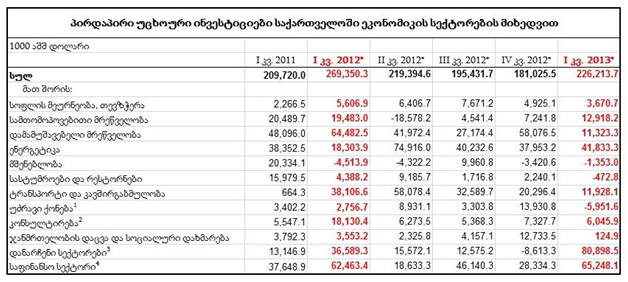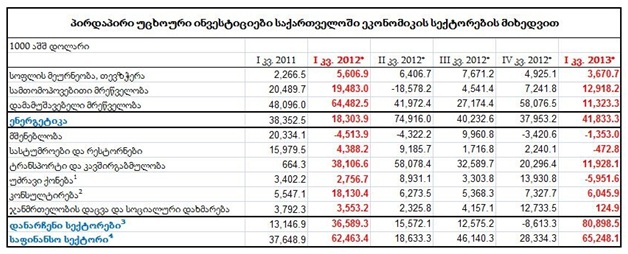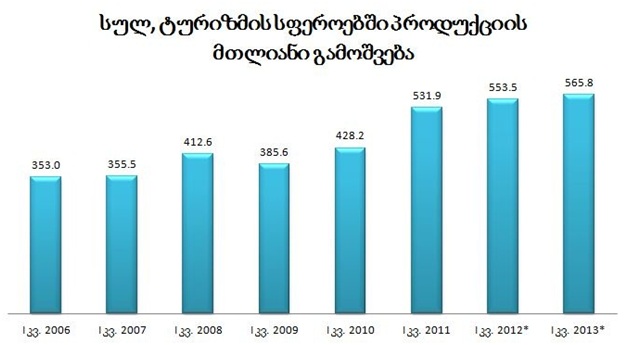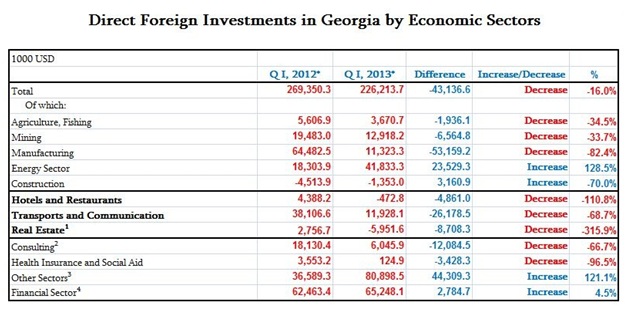At the Plenary session of the Parliament held on 29 July 2013, Pavle Kublashvili, member of Parliamentary Minority declared: “Not a single Lari has come into Georgia from the foreign direct investments. This is caused by the utmost unpredictability of the environment in the country. Nobody can predict what new initiatives will be made by certain MPs and how these initiatives will deteriorate the economic situation in the country. The only foreign direct investment is the money which comes through tourism.”
It is obvious that the aforementioned statement of the MP is hyperbolic, which is usually taken into consideration by the FactCheck. But this statement is still of interest to us, since it claims that there is a decline of foreign direct investments (FDI) in the sectors less related to tourism and growth of FDI in the sectors closely connected to the tourism.
FactCheck inquired about the accuracy of Pavle Kublashvili’s statement and analyzed the data published by the National Statistics Office of Georgia (GeoStat).

 This table contains data on the FDI broken down by economic sectors. As for “FDI in the tourism sector”, GeoStat does not count such category separately. GeoStat breaks down FDI only by the economic sectors shown above; for this reason, it is difficult to determine whether the FDI in the tourism sector has grown or not.
However, tourism is closely interconnected with such categories as Hotels and Restaurants, Transport and Communication, Real Estate and Lease. Therefore, analysis of the FDI in these fields will demonstrate whether the tourism growth brought in more FDI.
If we take a look at only those sectors which are considered to be less connected with tourism, we will see that FDI has not decreased in them, but quite on contrary, has increased substantially if compared to the corresponding quarter of the previous year.
This table contains data on the FDI broken down by economic sectors. As for “FDI in the tourism sector”, GeoStat does not count such category separately. GeoStat breaks down FDI only by the economic sectors shown above; for this reason, it is difficult to determine whether the FDI in the tourism sector has grown or not.
However, tourism is closely interconnected with such categories as Hotels and Restaurants, Transport and Communication, Real Estate and Lease. Therefore, analysis of the FDI in these fields will demonstrate whether the tourism growth brought in more FDI.
If we take a look at only those sectors which are considered to be less connected with tourism, we will see that FDI has not decreased in them, but quite on contrary, has increased substantially if compared to the corresponding quarter of the previous year.
 Analysis of the energy sector, financial sector as well as the group of sectors united under the heading “other sectors”, as the sectors less likely to be associated with tourism shows that the FDI made in these fields are considerably higher than in other fields. Based on the preliminary data on the first quarter of 2013, the FDI in these three sectors has actually grown as compared to the same indicator of the first quarter of 2012.
As for the sectors, which are more closely correlated with the tourism sector (hotels and restaurants; transport and communication; real estate and lease) we witness a decline of FDI as compared to the corresponding period of the previous year.
Analysis of the energy sector, financial sector as well as the group of sectors united under the heading “other sectors”, as the sectors less likely to be associated with tourism shows that the FDI made in these fields are considerably higher than in other fields. Based on the preliminary data on the first quarter of 2013, the FDI in these three sectors has actually grown as compared to the same indicator of the first quarter of 2012.
As for the sectors, which are more closely correlated with the tourism sector (hotels and restaurants; transport and communication; real estate and lease) we witness a decline of FDI as compared to the corresponding period of the previous year.
 Considering the fact, that GeoStat does not calculate FDI specifically in the tourism sector, we can say that Pavle Kublashvili’s statement is inaccurately formulated. In case the MP was referring to the sectors closely related to tourism, the FDI in these sectors is decreasing, as it was shown above, while in the fields less related to tourism it has increased.
In order to get a clearer picture we find it necessary to examine the number of tourists in Georgia in the first 6 months (we also separately analyze the first three months, i.e. the first quarter) of 2013. According to the available data, the number of tourists coming to Georgia has grown in the first six months of 2013. Perhaps this factor has served as the motivation for the abovementioned statement of the MP. However this indicator gives no ground whatsoever for assessing the amount of FDI in the tourism sector this year.
Considering the fact, that GeoStat does not calculate FDI specifically in the tourism sector, we can say that Pavle Kublashvili’s statement is inaccurately formulated. In case the MP was referring to the sectors closely related to tourism, the FDI in these sectors is decreasing, as it was shown above, while in the fields less related to tourism it has increased.
In order to get a clearer picture we find it necessary to examine the number of tourists in Georgia in the first 6 months (we also separately analyze the first three months, i.e. the first quarter) of 2013. According to the available data, the number of tourists coming to Georgia has grown in the first six months of 2013. Perhaps this factor has served as the motivation for the abovementioned statement of the MP. However this indicator gives no ground whatsoever for assessing the amount of FDI in the tourism sector this year.
 We also inquired to what extent the share of tourism had grown in the Total Output of Georgia in 2013. According to the preliminary data, Total Output of Production in the tourism sector has grown by 12.3 million GEL (2.2%) in 2013, as compared to the corresponding period of 2012. This does not represent a significant growth considering the increase in the number of tourists by 37% in the first quarter of 2013.
We also inquired to what extent the share of tourism had grown in the Total Output of Georgia in 2013. According to the preliminary data, Total Output of Production in the tourism sector has grown by 12.3 million GEL (2.2%) in 2013, as compared to the corresponding period of 2012. This does not represent a significant growth considering the increase in the number of tourists by 37% in the first quarter of 2013.
 If we compare the share of tourism in the total output of the country in the first quarter of 2013 to the same indicator of the first quarter of 2012, we see almost no change in numbers. In the first quarter of 2012, as well as in the first quarter of 2013, the share of tourism in the total output of the country was 6.7%. Accordingly, we witness insignificant increase in the income from the tourism sector.
If we compare the share of tourism in the total output of the country in the first quarter of 2013 to the same indicator of the first quarter of 2012, we see almost no change in numbers. In the first quarter of 2012, as well as in the first quarter of 2013, the share of tourism in the total output of the country was 6.7%. Accordingly, we witness insignificant increase in the income from the tourism sector.
 In the first quarter of 2013 a decline of FDI by 43.1 million USD is observed, as compared to the first quarter of 2012. It is worth noting that precisely the fields closely related to tourism (Transports and Communication, Hotels and Restaurants, Real Estate and lease) are largely responsible for the decrease – 39.7 million USD.
In the first quarter of 2013 a decline of FDI by 43.1 million USD is observed, as compared to the first quarter of 2012. It is worth noting that precisely the fields closely related to tourism (Transports and Communication, Hotels and Restaurants, Real Estate and lease) are largely responsible for the decrease – 39.7 million USD.
 Conclusion
In the three major fields, which are less likely to be associated with tourism (energy sector, financial sector, other sectors) a growth of FDI is evident; whereas in the fields closely linked with tourism (hotels and restaurants, transport and communication, real estate and lease) a clear decline is noticeable.
Despite the fact that the number of the tourists has grown, the share of tourism in the Total Economic Output of the country has remained almost unchanged.
Consequently, we conclude, that Pavle Kublashvili’s statement: “not a single Lari has come into Georgia by means of foreign direct investment. This is caused by the utmost unpredictability of the environment in the country. The only foreign direct investment made in the country is the money which comes through tourism,” is MOSTLY FALSE.
Conclusion
In the three major fields, which are less likely to be associated with tourism (energy sector, financial sector, other sectors) a growth of FDI is evident; whereas in the fields closely linked with tourism (hotels and restaurants, transport and communication, real estate and lease) a clear decline is noticeable.
Despite the fact that the number of the tourists has grown, the share of tourism in the Total Economic Output of the country has remained almost unchanged.
Consequently, we conclude, that Pavle Kublashvili’s statement: “not a single Lari has come into Georgia by means of foreign direct investment. This is caused by the utmost unpredictability of the environment in the country. The only foreign direct investment made in the country is the money which comes through tourism,” is MOSTLY FALSE.

 This table contains data on the FDI broken down by economic sectors. As for “FDI in the tourism sector”, GeoStat does not count such category separately. GeoStat breaks down FDI only by the economic sectors shown above; for this reason, it is difficult to determine whether the FDI in the tourism sector has grown or not.
However, tourism is closely interconnected with such categories as Hotels and Restaurants, Transport and Communication, Real Estate and Lease. Therefore, analysis of the FDI in these fields will demonstrate whether the tourism growth brought in more FDI.
If we take a look at only those sectors which are considered to be less connected with tourism, we will see that FDI has not decreased in them, but quite on contrary, has increased substantially if compared to the corresponding quarter of the previous year.
This table contains data on the FDI broken down by economic sectors. As for “FDI in the tourism sector”, GeoStat does not count such category separately. GeoStat breaks down FDI only by the economic sectors shown above; for this reason, it is difficult to determine whether the FDI in the tourism sector has grown or not.
However, tourism is closely interconnected with such categories as Hotels and Restaurants, Transport and Communication, Real Estate and Lease. Therefore, analysis of the FDI in these fields will demonstrate whether the tourism growth brought in more FDI.
If we take a look at only those sectors which are considered to be less connected with tourism, we will see that FDI has not decreased in them, but quite on contrary, has increased substantially if compared to the corresponding quarter of the previous year.
 Analysis of the energy sector, financial sector as well as the group of sectors united under the heading “other sectors”, as the sectors less likely to be associated with tourism shows that the FDI made in these fields are considerably higher than in other fields. Based on the preliminary data on the first quarter of 2013, the FDI in these three sectors has actually grown as compared to the same indicator of the first quarter of 2012.
As for the sectors, which are more closely correlated with the tourism sector (hotels and restaurants; transport and communication; real estate and lease) we witness a decline of FDI as compared to the corresponding period of the previous year.
Analysis of the energy sector, financial sector as well as the group of sectors united under the heading “other sectors”, as the sectors less likely to be associated with tourism shows that the FDI made in these fields are considerably higher than in other fields. Based on the preliminary data on the first quarter of 2013, the FDI in these three sectors has actually grown as compared to the same indicator of the first quarter of 2012.
As for the sectors, which are more closely correlated with the tourism sector (hotels and restaurants; transport and communication; real estate and lease) we witness a decline of FDI as compared to the corresponding period of the previous year.
 Considering the fact, that GeoStat does not calculate FDI specifically in the tourism sector, we can say that Pavle Kublashvili’s statement is inaccurately formulated. In case the MP was referring to the sectors closely related to tourism, the FDI in these sectors is decreasing, as it was shown above, while in the fields less related to tourism it has increased.
In order to get a clearer picture we find it necessary to examine the number of tourists in Georgia in the first 6 months (we also separately analyze the first three months, i.e. the first quarter) of 2013. According to the available data, the number of tourists coming to Georgia has grown in the first six months of 2013. Perhaps this factor has served as the motivation for the abovementioned statement of the MP. However this indicator gives no ground whatsoever for assessing the amount of FDI in the tourism sector this year.
Considering the fact, that GeoStat does not calculate FDI specifically in the tourism sector, we can say that Pavle Kublashvili’s statement is inaccurately formulated. In case the MP was referring to the sectors closely related to tourism, the FDI in these sectors is decreasing, as it was shown above, while in the fields less related to tourism it has increased.
In order to get a clearer picture we find it necessary to examine the number of tourists in Georgia in the first 6 months (we also separately analyze the first three months, i.e. the first quarter) of 2013. According to the available data, the number of tourists coming to Georgia has grown in the first six months of 2013. Perhaps this factor has served as the motivation for the abovementioned statement of the MP. However this indicator gives no ground whatsoever for assessing the amount of FDI in the tourism sector this year.
 We also inquired to what extent the share of tourism had grown in the Total Output of Georgia in 2013. According to the preliminary data, Total Output of Production in the tourism sector has grown by 12.3 million GEL (2.2%) in 2013, as compared to the corresponding period of 2012. This does not represent a significant growth considering the increase in the number of tourists by 37% in the first quarter of 2013.
We also inquired to what extent the share of tourism had grown in the Total Output of Georgia in 2013. According to the preliminary data, Total Output of Production in the tourism sector has grown by 12.3 million GEL (2.2%) in 2013, as compared to the corresponding period of 2012. This does not represent a significant growth considering the increase in the number of tourists by 37% in the first quarter of 2013.
 If we compare the share of tourism in the total output of the country in the first quarter of 2013 to the same indicator of the first quarter of 2012, we see almost no change in numbers. In the first quarter of 2012, as well as in the first quarter of 2013, the share of tourism in the total output of the country was 6.7%. Accordingly, we witness insignificant increase in the income from the tourism sector.
If we compare the share of tourism in the total output of the country in the first quarter of 2013 to the same indicator of the first quarter of 2012, we see almost no change in numbers. In the first quarter of 2012, as well as in the first quarter of 2013, the share of tourism in the total output of the country was 6.7%. Accordingly, we witness insignificant increase in the income from the tourism sector.
 In the first quarter of 2013 a decline of FDI by 43.1 million USD is observed, as compared to the first quarter of 2012. It is worth noting that precisely the fields closely related to tourism (Transports and Communication, Hotels and Restaurants, Real Estate and lease) are largely responsible for the decrease – 39.7 million USD.
In the first quarter of 2013 a decline of FDI by 43.1 million USD is observed, as compared to the first quarter of 2012. It is worth noting that precisely the fields closely related to tourism (Transports and Communication, Hotels and Restaurants, Real Estate and lease) are largely responsible for the decrease – 39.7 million USD.
 Conclusion
In the three major fields, which are less likely to be associated with tourism (energy sector, financial sector, other sectors) a growth of FDI is evident; whereas in the fields closely linked with tourism (hotels and restaurants, transport and communication, real estate and lease) a clear decline is noticeable.
Despite the fact that the number of the tourists has grown, the share of tourism in the Total Economic Output of the country has remained almost unchanged.
Consequently, we conclude, that Pavle Kublashvili’s statement: “not a single Lari has come into Georgia by means of foreign direct investment. This is caused by the utmost unpredictability of the environment in the country. The only foreign direct investment made in the country is the money which comes through tourism,” is MOSTLY FALSE.
Conclusion
In the three major fields, which are less likely to be associated with tourism (energy sector, financial sector, other sectors) a growth of FDI is evident; whereas in the fields closely linked with tourism (hotels and restaurants, transport and communication, real estate and lease) a clear decline is noticeable.
Despite the fact that the number of the tourists has grown, the share of tourism in the Total Economic Output of the country has remained almost unchanged.
Consequently, we conclude, that Pavle Kublashvili’s statement: “not a single Lari has come into Georgia by means of foreign direct investment. This is caused by the utmost unpredictability of the environment in the country. The only foreign direct investment made in the country is the money which comes through tourism,” is MOSTLY FALSE.







